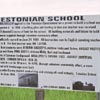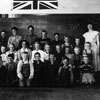Education
 Estonian pioneers were staunch supporters of educating their children and grandchildren. As a result, Alberta's Estonian communities organized schools and encouraged their children to complete all available schooling. A large proportion of Estonians went on to pursue a higher education at Alberta's colleges and universities.
Estonian pioneers were staunch supporters of educating their children and grandchildren. As a result, Alberta's Estonian communities organized schools and encouraged their children to complete all available schooling. A large proportion of Estonians went on to pursue a higher education at Alberta's colleges and universities.
With a well-established Estonian community living in the Medicine Valley, the idea of building a local school was well received. Estonian pioneer families recognized the urgent need for their children to learn English and other subjects. As early as 1905, Henry Kingsep arranged meetings with the local community to discuss various ideas. Within a few years, with funds and resources available, a central site was chosen for the school and the Estonian School District's borders were mapped out, designating who was eligible to attend. The school board consisted primarily of local Estonian farmers who collected the school tax, hired a teacher, and maintained the school.
Opening in the fall of 1909, the Estonian School was located on the northeast corner of Carl Langer's property. The school was another community-based initiative built from lumber hauled in from mills scattered throughout the general area. Duncan Layton was one of the school's first teachers, providing English to everyone so as to meet the needs of the entire community. In its inaugural year, the Estonian School taught 17 students ranging between the ages of 6 and 13.
 By 1915, the Estonian School District had enrolled 52 students, many of whom travelled miles and miles to attend. There was no gymnasium; however, most students were probably content with their daily exercise consisting of walking miles to and from school in a variety of unsettling weather conditions. Estonians and non-Estonians alike shared the school, learning English, history, and general sciences. The intellectuals of the local community were the school teachers; subsequently, they were constantly treated with courtesy and admiration. With a passion for music and the arts, members of the Estonian community raised money to allow the school to purchase a gramophone and a piano.
By 1915, the Estonian School District had enrolled 52 students, many of whom travelled miles and miles to attend. There was no gymnasium; however, most students were probably content with their daily exercise consisting of walking miles to and from school in a variety of unsettling weather conditions. Estonians and non-Estonians alike shared the school, learning English, history, and general sciences. The intellectuals of the local community were the school teachers; subsequently, they were constantly treated with courtesy and admiration. With a passion for music and the arts, members of the Estonian community raised money to allow the school to purchase a gramophone and a piano.
 By the early 1950s, the centralization of rural schools became popular as a means of providing a better quality education within an economically feasible budget. The Rocky Mountain School Division soon transferred Grades 7 and 8 to Eckville and provided bus transportation. The Estonian School was lifted and hauled into Eckville where it joined the school there and served as a home economics classroom. Eckville's school featured one teacher per grade, a gymnasium, and several classrooms.
By the early 1950s, the centralization of rural schools became popular as a means of providing a better quality education within an economically feasible budget. The Rocky Mountain School Division soon transferred Grades 7 and 8 to Eckville and provided bus transportation. The Estonian School was lifted and hauled into Eckville where it joined the school there and served as a home economics classroom. Eckville's school featured one teacher per grade, a gymnasium, and several classrooms.
In 1961, the County of Lacombe assumed responsibility for the educational needs of students living in Eckville and the surrounding area. Unfortunately, all records related to the Estonian School were destroyed upon the transfer from Eckville to Lacombe. The original site of the Estonian School reverted to Carl Langer's property.
Norma School near Sylvan Lake
 Norma School, named after a local district near Sylvan Lake, opened in May, 1904 as "Finland School" with 21 students. Mr. George H. Glover, who led church services, was the first teacher. The school was on homestead land of Johan Kask.
Norma School, named after a local district near Sylvan Lake, opened in May, 1904 as "Finland School" with 21 students. Mr. George H. Glover, who led church services, was the first teacher. The school was on homestead land of Johan Kask.
In 1909, the name of the school changed to Sylvan Lake School; in 1915 it was renamed Norma School. The school, a log building, was rebuilt in 1929. When the second school was closed in 1956 or 1957, the remaining 16 students were bussed to Sylvan Lake or Red Deer.








